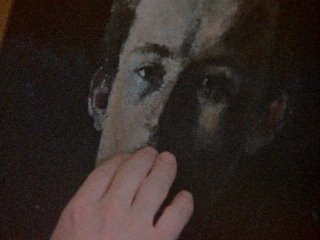7/30/2006
The Total Artist Film: EDVARD MUNCH

After making a handful of excellent amateur films, Peter Watkins jumped head-first into the international film and TV scene with Culloden (1964). The critical and popular success of that historical telefilm, which dynamized one of the key battles in British history, lead to the realization of his urgent pet-project: The War Game (1966). The intriguing and sordid tale of that production is best saved for another day - regardless, it soured Watkins' taste for conventional media channels.
He permanently relocated to Sweden in the early 1970s (he made The Gladiators there in 1969 but then ventured to the United States for the incendiary Punishment Park). All of his work challenges assumptions about viewing positions, the relationship between history and visual representation, and the broadest possible conceptions of objectivity/subjectivity.
Edvard Munch (1975) is considered his best work, and for good reason. I cannot think of another artist film besides Ken Russell's Savage Messiah (1972) that does so good a job at encapsulating, investigating, and explaining the life of a creative genius in the visual arts.
Munch lead a tortured life. He was at odds with the conservative art world of Norway and too morose for other circles on the continent. His circle in Berlin often cast him to the periphery. Beyond all else, his art was haunted by memory - the memory of the tragic health of his family members and the memory of the lost love of a woman.

Watkins literally places himself into Munch's world - he provides powerful narration, but also configures the story to mirror his own experience. Munch was at odds with the critical establishment, was forced to "check" his artistic ambitions as a young man (Watkins' War Game), and endured a continual chastising for his techniques.
The story of Munch's life is not strictly chronological, but rather dialogical. Images of various eras of the man's life are often thrown together with intensity. Munch's art is the result of genius, madness, and memory. The narration of Watkins mixes with direct interviews. The characters in the story often look into the camera, in both confusion and sincerity. As viewers, we are implicated - we must feel Munch's pain and address the montage of his life.
Watkins goes one further and captures the techniques and textures of Munch in presenting his story. Munch's canvases were known for their expressive quality. His willingness to scratch his paintings , mix oil with egg tempra, or even use unprimed canvases, gives his work a powerful aura. Watkins utlizes grainy stocks, zooms, and often allows the camera to lapse into and out of focus. The result is a close approximation to the murky membrane over many of Munch's paintings.
Click here for an interview with Watkins.

After making a handful of excellent amateur films, Peter Watkins jumped head-first into the international film and TV scene with Culloden (1964). The critical and popular success of that historical telefilm, which dynamized one of the key battles in British history, lead to the realization of his urgent pet-project: The War Game (1966). The intriguing and sordid tale of that production is best saved for another day - regardless, it soured Watkins' taste for conventional media channels.
He permanently relocated to Sweden in the early 1970s (he made The Gladiators there in 1969 but then ventured to the United States for the incendiary Punishment Park). All of his work challenges assumptions about viewing positions, the relationship between history and visual representation, and the broadest possible conceptions of objectivity/subjectivity.
Edvard Munch (1975) is considered his best work, and for good reason. I cannot think of another artist film besides Ken Russell's Savage Messiah (1972) that does so good a job at encapsulating, investigating, and explaining the life of a creative genius in the visual arts.
Munch lead a tortured life. He was at odds with the conservative art world of Norway and too morose for other circles on the continent. His circle in Berlin often cast him to the periphery. Beyond all else, his art was haunted by memory - the memory of the tragic health of his family members and the memory of the lost love of a woman.

Watkins literally places himself into Munch's world - he provides powerful narration, but also configures the story to mirror his own experience. Munch was at odds with the critical establishment, was forced to "check" his artistic ambitions as a young man (Watkins' War Game), and endured a continual chastising for his techniques.
The story of Munch's life is not strictly chronological, but rather dialogical. Images of various eras of the man's life are often thrown together with intensity. Munch's art is the result of genius, madness, and memory. The narration of Watkins mixes with direct interviews. The characters in the story often look into the camera, in both confusion and sincerity. As viewers, we are implicated - we must feel Munch's pain and address the montage of his life.
Watkins goes one further and captures the techniques and textures of Munch in presenting his story. Munch's canvases were known for their expressive quality. His willingness to scratch his paintings , mix oil with egg tempra, or even use unprimed canvases, gives his work a powerful aura. Watkins utlizes grainy stocks, zooms, and often allows the camera to lapse into and out of focus. The result is a close approximation to the murky membrane over many of Munch's paintings.
Click here for an interview with Watkins.



